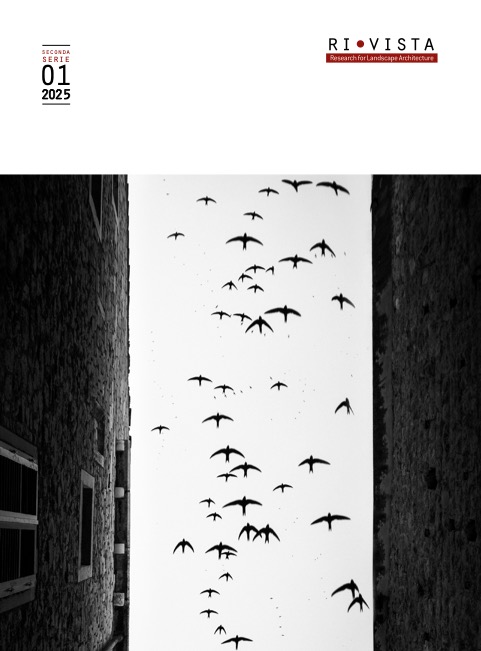Published 2025-10-28
Keywords
- Open space,
- Landscape-based epistemology,
- Relational spatiality,
- Socio-ecological subjectivities,
- Design agency
How to Cite
Copyright (c) 2025 Duarte Santo, Maria Goula

This work is licensed under a Creative Commons Attribution 4.0 International License.
Abstract
This article reclaims open space as a critical category for landscape architecture, challenging its reduction to a void to be programmed amid socioecological crisis. It theorises open space as a contested dynamic assemblage where ecological processes, colonial histories and more-than-human agencies intersect with design’s technocratic impulses. Drawing on relational spatiality, we argue for a pluriversal theoretical framework that is attentive to overlaps, tensions, and entanglements, interrogating how this construct supports design agency amid complexity and inequality. Using the Puente Hills Landfill as a case study and boundary object, we examine how openness manifests across temporal, material and social registers, predicating open space as a generative, open-ended system and performative terrain where ecological subjectivities, cultural inscriptions, and socio-political claims converge, demanding a radical reorientation of design agency and landscape architecture’s epistemic boundaries.
References
- Mbembe A. 2020, Necropolitics, Duke University Press. DOI: https://doi.org/10.1515/9781478007227
- Allen S. 1999, Points and Lines: Diagrams and Projects for the City, Princeton Architectural Press.
- American Society of Landscape Architects (ASLA) 2024, Puente Hills Landfill Park, ASLA Awards, < https://www.asla.org/2024awards/9964.html> (05/25).
- Anderson B. 2009, Emotion, Space and Society, «Affective Atmospheres», vol.2, n.2, pp. 77-81. DOI: https://doi.org/10.1016/j.emospa.2009.08.005
- Barad K. 2007, Meeting the universe halfway: Quantum physics and the entanglement of matter and meaning, Duke University Press. DOI: https://doi.org/10.2307/j.ctv12101zq
- Bennett J. 2010, Vibrant matter: A political ecology of things, Duke University Press. DOI: https://doi.org/10.1215/9780822391623
- Brake M, 2024, California Allocates $125 Million to Landfill Park Transformation. Planetizen, <https://www.planetizen.com/news/2024/06/129889-california-allocates-125-million-landfill-park-transformation> (05/25).
- Brenner N. 2019, The urban question and the scale question: Some conceptual clarifications, «City», vol.23, n.5, pp. 704-715.
- Butler J. 2001, Giving an account of oneself, «Diacritics», vol.31, n.4, pp. 22-40. DOI: https://doi.org/10.1353/dia.2004.0002
- Corajoud M. 2001, Les neuf conduites nécessaires d’une propédeutique pour un apprentissage du projet sur le paysage, Jardins Insurgés, architecture du paysage en Europe, Catalogue de la II Biennale Européenne du Paysage, Barcelona, pp. 119-132.
- County of Los Angeles Department of Parks and Recreation, Puente Hills Landfill Park Master Plan, <https://parks.lacounty.gov/phlandfillpark/> (05/25)
- Derrida J. 1976, Of Grammatology, trans. Gayatri Chakravorty Spivak, The Johns Hopkins University Press [First published 1967].
- DuFour T. 2021, Husserl and Spatiality: A Phenomenological Ethnography of Space, Routledge. DOI: https://doi.org/10.4324/9781351116145
- Haraway D. 2016, Staying with the Trouble: Making Kin in the Chthulucene, Duke UP. DOI: https://doi.org/10.2307/j.ctv11cw25q
- Harvey D. 2012, Rebel cities: From the right to the city to the urban revolution, Verso Books.
- Houston D., McCallum D., Steele W., Byrne J. 2016, Climate Cosmopolitics and the Possibilities for Urban Planning, «Nature and Culture», vol.11, n.3, pp. 259-277. DOI: https://doi.org/10.3167/nc.2016.110303
- Ingold T. 2021, Being alive: Essays on movement, knowledge and description, Routledge. DOI: https://doi.org/10.4324/9781003196679
- Laclau E. 1992, Beyond emancipation, «Development and change», vol.23, n.3, pp. 121-137. DOI: https://doi.org/10.1111/j.1467-7660.1992.tb00459.x
- Latour B. 2014, Some advantages of the notion of “Critical Zone” for geopolitics, «Procedia Earth and Planetary Science», n.10, pp. 3-6. DOI: https://doi.org/10.1016/j.proeps.2014.08.002
- Lefebvre H. 1991, The production of space, trans. Donald Nicholson-Smith, Blackwell, Oxford [First published 1974].
- Massey D. 2005, For space, Sage. DOI: https://doi.org/10.12968/sece.2005.1.361
- Philippopoulos-Mihalopoulos A. 2013, Atmospheres of law: Senses, affects, lawscapes, «Emotion, space and society», n.7, pp. 35-44. DOI: https://doi.org/10.1016/j.emospa.2012.03.001
- Pulido L. 2017, Rethinking environmental racism: White privilege and urban development in Southern California, «Environment», Routledge, pp. 379-407. DOI: https://doi.org/10.4324/9781315256351-17
- Said E. 1978, Orientalism, Pantheon Books.
- Star S.L., Griesemer J.R. 1989, Institutional ecology, translations' and boundary objects: Amateurs and professionals in Berkeley's Museum of Vertebrate Zoology, 1907-39, «Social studies of science», vol. 19, n.3, pp. 387-420. DOI: https://doi.org/10.1177/030631289019003001
- Studio-MLA 2025, Puente Hills Landfill Park, <https://studio-mla.com/design/puente-hills-landfill-park/> (05/25).
- Trompette P., Vinck D. 2009, Revisiting the notion of boundary object, «Revue d'anthropologie des connaissances», vol.31, n.1, pp. 3-25. DOI: https://doi.org/10.3917/rac.006.0003
- Tsing A.L. 2015, The mushroom at the end of the world: On the possibility of life in capitalist ruins, Princeton University Press. DOI: https://doi.org/10.1515/9781400873548






